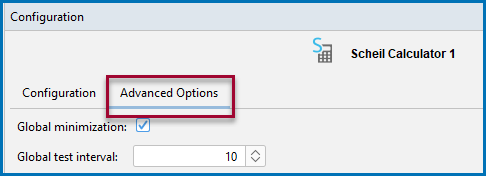Scheil Calculator: Advanced Options
This topic has advanced settings information for the Scheil Calculator Configuration window. The main settings are on the Configuration tab.
Scheil Calculator: Configuration Window Settings
Click the Advanced Options tab to adjust the following default settings as needed.
To make global default setting changes, see Global Settings: Scheil Calculator.
Global minimization is enabled by default i.e. the Global minimization checkbox is selected.
It is recommended to keep global minimization on as it makes the calculation more accurate. However, turn it off if you find that the calculation is taking too long for any particular system, and accuracy is not the highest priority.
For this setting, a global equilibrium test is performed at selected intervals when an equilibrium is reached. By default it is at every 10 th Scheil step but this can be changed using the Global test interval setting. The global equilibrium test is also done every time the set of stable phases tries to change. This costs more computer time but the calculations are more robust.
Use the Global test interval setting to change the interval at which a global equilibrium test is done, which by default is every 10th step as long as there are no changes in the set of stable phases. Every time the set of stable phases tries to change, a global equilibrium test is also done regardless of the test interval value chosen. A global equilibrium test means that the calculated equilibrium state obtained by the ordinary minimization calculation is tested against the Global Minimization Technique, and if the result is found unstable then the full global minimization calculation is performed instead.
Use the Max grid points to set the maximum number of grid points per phase for global minimization. The default is 2000.
The default in the list is the LIQUID phase already defined in the chosen database.
The default in the list is the Gas phase already defined in the database
Select the Calculate evaporation properties checkbox to calculate the Molar mass of gas, Driving force for evaporation, and Evaporation enthalpy properties.
A gas phase is required to calculate these properties.
This option sets the gas phase to dormant, meaning that the thermodynamic properties of the gas are evaluated, without the gas being allowed to form. This enables the calculation of the following properties: Molar mass of gas, Evaporation enthalpy, and Driving force for evaporation. Driving force for evaporation is positive when the gas is stable (temperature above evaporation temperature). A negative driving force means the gas is metastable.
This setting controls when a Scheil calculation should terminate. From the Terminate Scheil on list, choose Fraction of liquid phase (unit = mole fraction) or Temperature and enter a value in the field.
Enter or choose a value for the Max no. of iterations. By default, the program tries 500 iterations before it gives up. As some models give computation times of more than 1 CPU second/iteration, this number is also used to check the CPU time and the calculation stops if 500 CPU seconds/iterations are used.
The default Required accuracy is 1.0E-6. This is a relative accuracy, and the program requires that the relative difference in each variable must be lower than this value before it has converged. A larger value normally means fewer iterations but less accurate solutions. The value should be at least one order of magnitude larger than the machine precision.
The default Smallest fraction (or Smallest fraction in a phase for Property Models) is 1.0E-12. This is the value assigned to constituents that are unstable. It is normally only in the gas phase you can find such low fractions.
The default value for the smallest site-fractions is 1E-12 for all phases except for IDEAL phase with one sublattice site (such as the GAS mixture phase in many databases) for which the default value is always as 1E-30.
The Approximate driving force for metastable phases checkbox is selected by default. Click to clear the checkbox to change the default as required and based on the options described below.
This setting involves the convergence of metastable phases and affects their driving forces. It can also have an effect on when an equilibrium is considered successful.
The default is to allow an equilibrium with metastable phases that have not converged, as long as the stable phases have converged. This is efficient but often causes approximate values of the driving forces for the metastable phases.
If you change the default, it enforces metastable phases to converge. This gives accurate driving forces for metastable phases as well as stable phases. It can however take a slightly longer time, and if metastable phases do not converge it causes the equilibrium calculation to fail.
The Include one axis equilibrium calculation checkbox is selected by default and a One Axis (also called step) calculation is performed before the actual Scheil calculation. It produces the solidification curve under equilibrium conditions and it is shown on the plot if the default axis variables are used. This is sometimes referred to as the equilibrium line.
If a comparison to equilibrium is not necessary, change the default setting and then only a Scheil calculation is performed. This results in a much faster calculation, which for a complex system may be preferable.
The Temperature below solidus settings are available when Temperature below solidus is selected for Calculate to. This calculates the properties for the given number of temperatures, down to the final temperature for the phase compositions and fractions at the solid phases at the end of the Scheil calculation.
- Enter the No. of points. The default is 50.
- Enter the Final temperature. The default is room temperature (298.15 K).
